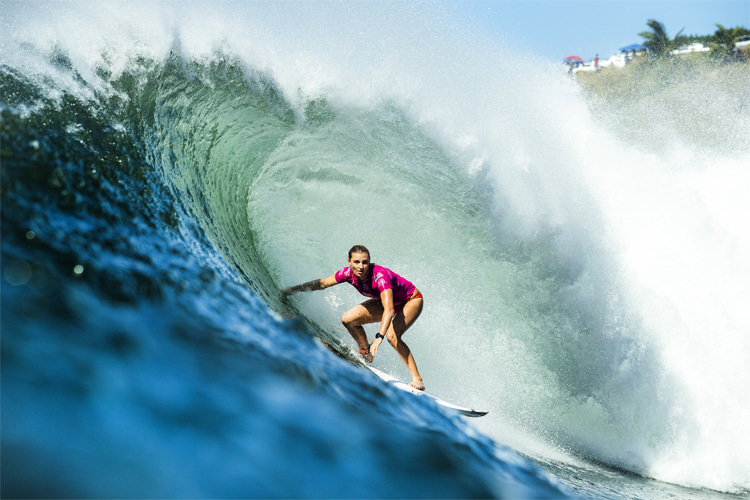Honolua Bay is home to a hollow, powerful, long, multi-section wave, making it one of Hawaii's most epic surf breaks.
Australian surfing legend and four-time world champion Mark Richards once named it "the ultimate wave - the best wave in the world."
No wonder Honolua Bay has been the chosen site for several men's and women's world tour events in Maui since the 1980s.
The iconic secluded spot is located northwest of Maui, sheltered by green valleys and hills between Kapalua and Punalau Beach.
Its vibrant greenish-blue waters often became a surfer's dream right-hand wave with plenty of barrels and ramps for accomplished aerialists.
Despite being one of the windiest Hawaiian islands, Maui has world-class surf spots that rise to perfection when Oahu's North Shore is too big for 99 percent of wave riders.
"It is still a surfer's paradise, less expensive and exhausting than an Indo boat trip, with much more cultural stimulation when the waves are flat than is usually available at a surf resort," note Leonard and Lorca Lueras, authors of "Surfing Hawaii."
Honolua means "two harbors" in Hawaiian.
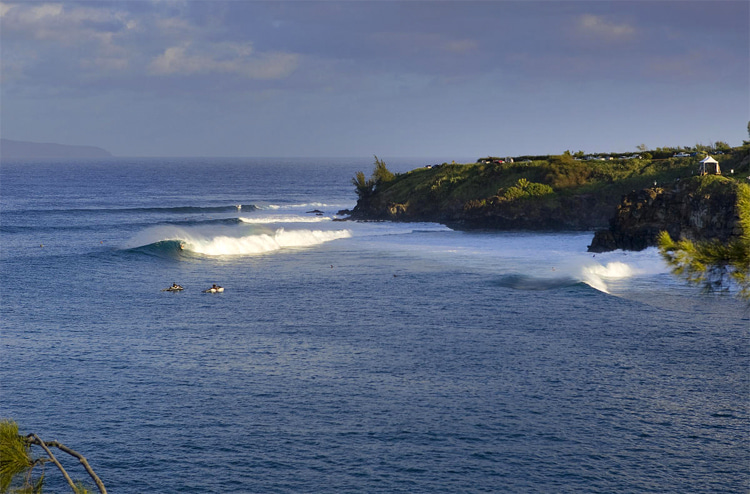
Maui Weather and Swells
Maui boasts one of the world's top point breaks - Honolua Bay - and the fastest wave - Maalaea - along with numerous other hollow reef spots in an ocean that is refreshingly cool during hot weather yet refreshingly warm during colder conditions.
Conditions become perfect for windsurfers and kitesurfers when howling winds make waves unappetizing to surfers.
And if you can't afford to rent a car, hitchhiking is legal, although it can be time-consuming.
As the state's second-largest island, it can take forever to get from one side of the island to another, chasing after favorable swell and wind conditions.
Because of its unusual configuration, Maui essentially has two surfable shores (north and west).
The northern coastline has northerly and easterly components, and the west side has northerly and southerly elements.
The north and east parts of the island are lush and wet, with tropical forests extending to the shoreline, while the west side is arid and dry, becoming more moist and green north of Lahaina.
Hawaii's prevailing winds will always determine whether the surf will be prime time or wasted time.
Trade winds blow offshore on northwest/southwest shores, while Kona winds (westerlies) turn the usually bumpy waters off northeast/east shores into visions of pristine delight.
Additionally, mornings can be smooth and clean before the trade winds pick up.
And during winter especially (and sometimes during summer), the high-pressure cell that usually dominates the eastern Pacific breaks down, creating a land/sea breeze regime with light offshore winds around the entire island in the morning, replaced by onshore winds by noon.
Without waves, none of this matters.
Each side of the island has the usual wave patterns that show variations from time to time but are usually predictable.
The northwest/northeast shores enjoy the best swells during winter (October through April) from fierce storms that leave the Asian mainland and rage across the Gulf of Alaska on their way to the US mainland.
These booming west/northwest swells can reach down the northwest coast to Lahaina, bringing life to spots from Windmills to Hana on the northeast/east coast.
The cold fronts from these winter storms that pass over the island are preceded by Kona (southwesterly to westerly) winds that clean up the waves on the usually onshore windward side of Maui.
The Bay works best with an NNE, N, NNW, and W swell; Molokai blocks NW swells unless they are large enough to wrap.
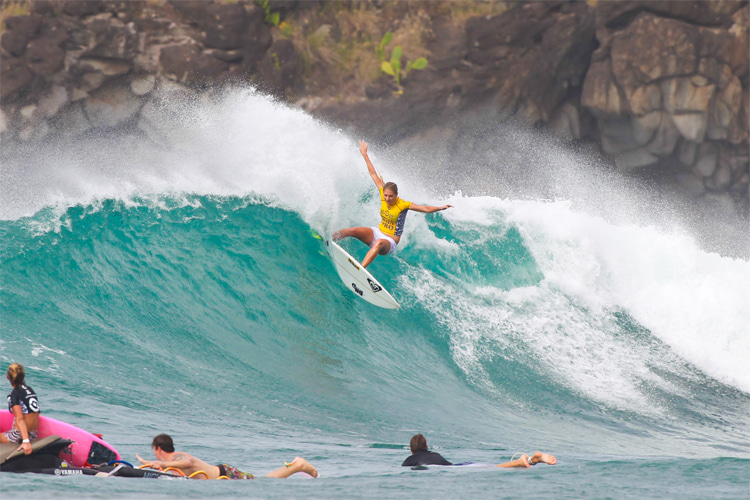
History of Surfing in Honolua Bay
According to surf historian Matt Warshaw, "Oahu surfers George Downing, Wally Froiseth, and Russ Takaki are sometimes credited as the first to ride Honolua Bay in 1947."
"Maui brothers Don and Tairu Uchimura may have been on it even earlier, but until the early 1960s, the semi-remote break was rarely surfed."
"'The Performers,' a 1965 surf movie, featured a Honolua sequence filled with glorious six-foot waves, which helped put the spot on the map, and Oahu-based surfers were soon beginning to fly over by the dozens when the swell got big enough."
Hawaiian surfer Barry Kanaiaupuni once described Honolua's cliff-lined shore as "a place that just ate surfboards - 15 to 20 boards a day sometimes."
Maui's world-class right-hand point break is part of the so-called shortboard revolution.
It was featured in 1967's "The Hot Generation," a film starring 1966 surfing world champion Nat Young and the legendary Bob McTavish getting barreled and performing innovative maneuvers on their smaller surfboards.
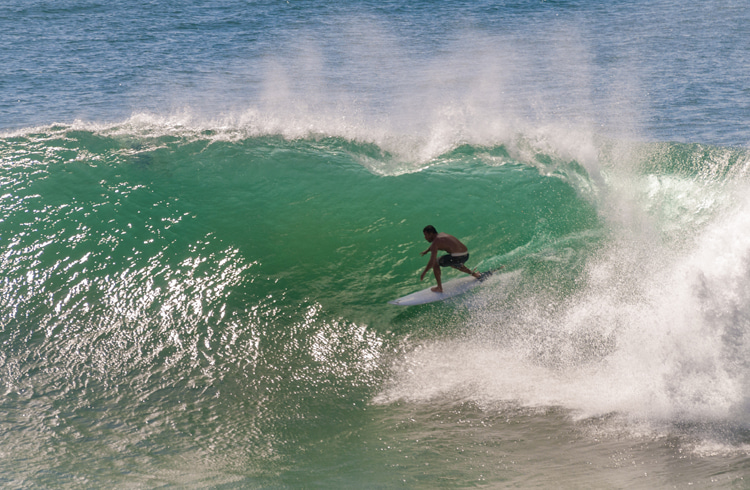
The Sections of the Wave
The Honolua Bay surf provides long, hollow sections that bend and wrap around the stunningly beautiful rocky outcroppings nearby.
When the wind (trades are offshore), swell (N, NNW, or NNE), and tide (medium is best) cooperate, the wave is a slice of heaven.
It ranges from fun at two to four feet, exciting at five to eight feet, challenging at ten to 12 feet, and terrifying at 15 to 20 feet.
The renowned Maui point break offers four main peaks:
1. Coconut Grove
Coconut Grove is the famous outside take-off zone located on the far north end.
It's where the incoming wave gains its size and shape, and the wind is strongest.
Nevertheless, you have to speed up past the cliffs to make it to the next section.
2. The Cove/The Point
The wave is sculpted and ready to be ridden as the swell hits the naturally designed bathymetry.
The Cove is Honolua Bay's most popular take-off spot, and it is often crowded.
After popping up, the surfer will enjoy several bowl sections before getting ready for the upcoming challenge.
When the wave ends, you may sometimes go left.
3. The Cave
The Cave is where the magic happens and probably the most sought-after Honolua Bay wave-riding experience.
It's the unrivaled high-performance section with plenty of oblique walls for turns and cylinders for tube riding.
But it is also a tricky racing track that suddenly jacks up and moves around depending on the swell conditions.
It is named after a scary hole in the underwater reef that can suck surfers and boards and rises in front of the local rock cliff.
As the wave races across the Cave, it starts barreling and providing numerous blue and thick caverns.
With offshore winds blowing from the southeast, Honolua Bay reaches its perfection stage.
4. Keiki Bowls
The Keiki Bowl is Honolua Bay's end section.
If you've made it through the Cave, you should expect a section that breaks over shallow water - around two feet - and a sharp reef.
It is a fast and smaller section offering three sections that can occasionally connect into a long ride.
Keiki Bowl is often bodyboarders' and groms' favorite section as they warm up and practice for taking on the outer take-off zones.
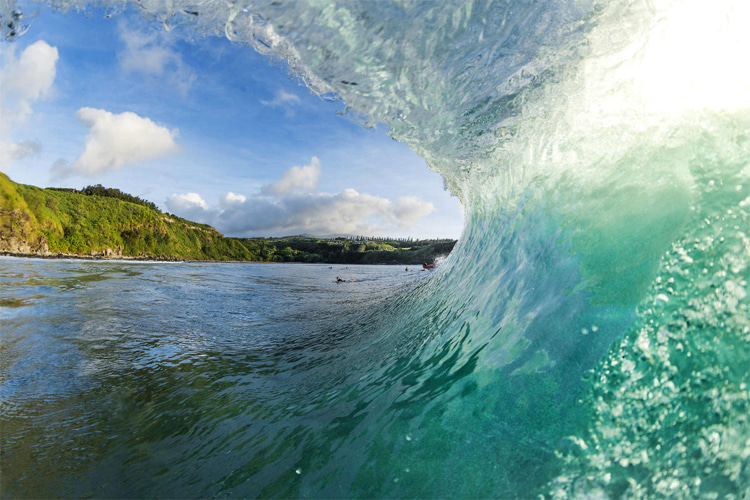
When to Surf Honolua Bay
Honolua Bay is a sensitive and fickle surf break when it comes to consistency.
It is often flat in the summer (October to April), suiting only passionate divers, snorkelers, swimmers, and beachgoers.
As the winter arrives, North Pacific groundswells start to get through the islands of Molokai and Lanai via the narrow Kalohi Channel and reach the sheltered Maui cove.
And that's precisely when pristine surfing waves roar to life, making it possible to surf 250 years from Coconuts to the Keiki Bowls.
If you have to pick a month, it has to be January, the month that will probably deliver 15 days of above-average waves.
On special days, with the right swell angle, you should be able to get 20-foot rollers peeling fast across the natural indentation.
The Maui exposed point/reef break should be surfed on mid-tide, and it is often crowded on epic days.
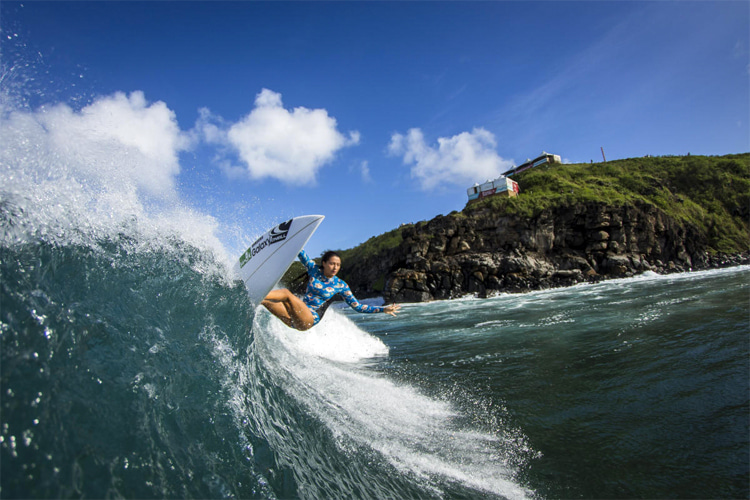
Hazards, Warnings, and Handy Tips
Beware of the rip currents, sharks, and urchins.
If you wipe out, corals may leave a mark on your body. Also, be prepared for unexpected changes in swell conditions.
You might be enjoying two-foot ripples on a longboard and suddenly paddling for your life in double overhead waves and getting caught inside.
And remember to respect the locals and follow the basic informal rules of surf etiquette.
The Maui surf crew has to wait a long for their share of memorable sessions, so when the waves arrive, they will make sure they own them.
Be patient and wait for your turn, even though experienced surfers will rarely fall or wipe out in the best sections.
If you're a spectator, a surf fan, or it's simply too big for you, check the surrounding cliffs for amazing views of the Honolua Bay waves.
There's even a slippery goat or dirt trail you can follow to get to a flat grassy area that puts you in a privileged position to watch surfers perform at the Cave.
On the opposite side of the Bay, there's also a parking lot with a straight-angle view of the surf.
Honolua Bay, Maui, Hawaii | ID and X-Ray
Location: Maui, Hawaii, USA
Type of Wave: Righ-Hand Point/Reef Break
Length: Up to 250 yards (228 meters)
Best Swell Direction: NNW to NNE, NE, and NW
Best Wave Size: 6-20 feet
Best Wind Direction: Light or Offshore (ENE to SE)
Best Tide: Medium
Best Time to Surf: Winter (October through April)
Skill Level: Intermediate, Advanced, and Professional
Best Board: Shortboard, Funboard, Longboard, Bodyboard
Crowd: On Epic Days
Water Quality: Good
Hazards: Reef, Rocks, Rips, Urchins, Sharks
Bottom: Reef, Rock, and Sand
Water Temperature: 75-82 °F (24-28 °C)
Getting There: Paddle Out
Bibliography and References:
Leonard Lueras, Lorca Lueras. "Surfing Hawaii: The Ultimate Guide to the World's Most Challenging Waves." Periplus Editions, 2000
